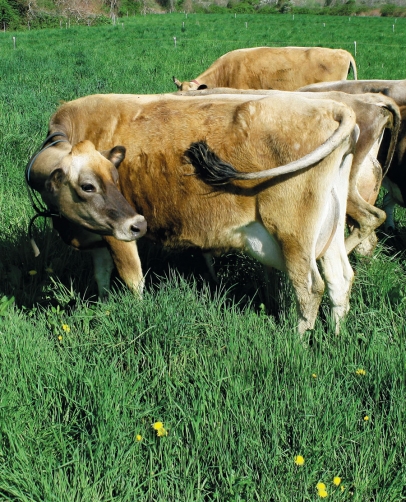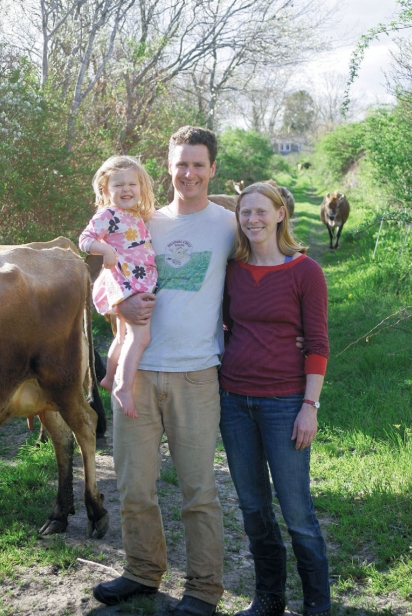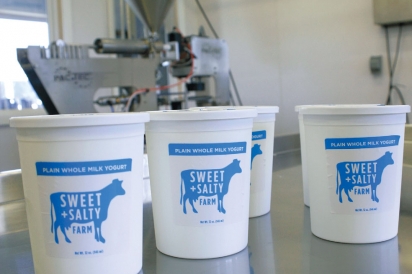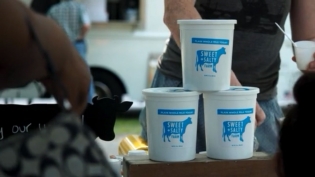Sweet & Salty Farm Heralds Return of a Dairy in Little Compton
Ten years ago Laura Haverland and Andrew Morley sat at their desk jobs in Manhattan dreaming of cow pastures. The young couple longed for their days to be filled with cowbells and cheese curds instead of client meetings and subway commutes.
Dairy farming in his blood, it was Andrew who first pulled the plug on the 9 to 5 and headed upstate to apprentice and learn the art of cheesemaking at the Stone Barns Center, one of the leaders in sustainable agriculture education nationwide. Andrew then spent time working at dairies in Vermont and Virginia while Laura held down the fort in New York City, making plans for her own escape.
In 2011 the couple moved to Little Compton to begin their next chapter as dairy farmers. With family already in Rhode Island, they’d fallen in love with Little Compton on previous visits, so the decision of where to relocate was a relatively easy one. Laura and Andrew agreed “if we were going to never take a vacation again, we might as well live somewhere where other people like to vacation.”
They received a tip about Whimshaw Farm, an old dairy on Shaw Road just across the street from Wishing Stone Farm, with pastures slanting right down to the sea. A few phones calls were made and Laura and Andrew were introduced to Linda and Emerson Wildes. (The Wildeses retired from farming in 1991 but still live on the property.) Whimshaw Farm has been in their family and the land farmed for nearly 400 years.
Laura and Andrew spent the next several months getting to know the Wildeses over lengthy cups of tea and conversation in their kitchen. It was a year into their friendship before the topic of a lease was even touched upon.
“We knew that dairy farming takes a lot out of the farmer and if they were up for it, we wanted to give this young couple a shot to make it work—and keep our land in dairy farming,” said Linda Wildes. It seemed a natural fit and a long-term lease was agreed upon. Today Laura and Andrew’s dreams are an everyday reality at Sweet & Salty Farm, where they raise Jersey cows for whole-milk yogurt and aged natural rind cheese.
From the beginning the Sweet & Salty philosophy was to start small and leave plenty of room to make mistakes, learn and grow into something larger.
“We have had wonderful mentors, and one of them in particular reminded us that you can always buy more cows, but it’s not very easy to sell them!” said Laura. So from the beginning each step was planned deliberately with the intention of growing in the future.
Their first phase was designing and building their own manufacturing facility to include a milking parlor, milk house, food processing and storage rooms. Working with a designer they used a lot of creative ideas, recycled materials and collaborative gumption to build a sparkling clean facility with a natural flow from pasture to product—and one that boasted spectacular views of the pastures outside. The facility is Laura and Andrew’s largest investment in their farm and they want it to be a space they can work with for a long time to come.
This year Sweet & Salty has grown to include nine milking cows (from five last year) and two yearlings, all Jerseys, with nine calves arriving in spring. In the grazing season the cows are always out on pasture and are moved twice a day so that they continually have something fresh to eat. (The farmland includes 30 acres of pasture, leased again from two different neighbors committed to keeping the land in farming.)
When the cows return to pasture from the milking parlor two times a day, they stop by the “free choice mineral feeder” where supplements of 18 different minerals are made available to them. The idea is that the cows choose to eat the minerals that they need most at the time. As the seasons change, so too do the supplements. In early spring the cows were eating a lot of kelp, which is heavy in magnesium and during the summer they gravitate towards higher calcium. Absolutely no antibiotics or hormones are used, ever. In the winter the cows always get a 60-day break from milking, before calving season begins.
“Our cows are the most important part of our farm ecosystem—earthworms are the second, but we don’t milk them—so we try to make every decision with their welfare first in mind,” says Laura.
Significant attention is paid to keeping the milking parlor exceptionally clean. In truth, more time is given to cleaning the parlor than to the actual milking. From the earliest stage of processing, this insures that the milk is of the highest quality. Milk can take on the taste of the environment where the cows live—pure milk from healthy, clean cows is the goal.
In the milk house the fresh milk is stored and refrigerated. It then gets pumped into the cheese and yogurt processing room through stainless steel pipes. Milk for both cheese and yogurt goes into a combo-pasteurizing vat. From there the yogurt is machine packaged and incubated in a warm room until it reaches the desired pH. The cheeses are aged in a semi-underground section of the facility that was designed around an existing slope in the land and creates a cave-like environment.
Sweet & Salty yogurt is a plain, whole-milk, cream-on-top variety. The plants and grasses the cows eat give it a naturally sweet, rich and creamy taste. There are no added sugars, flavors or preservatives—the milk is as fresh and pure as it can be and the end product reflects that. Andrew and Laura are experimenting with three cheese varieties: soft and creamy; stinky and pungent; and aged and complex. This should cover the bases for most cheese lovers and, most importantly, be a true reflection of Sweet & Salty Farm and the experiences that have gotten them to where they are today. This year’s cheese production will begin in the summer.
Laura and Andrew speak incredibly humbly about their new lives as dairy farmers. They have continually given themselves space to grow and recognize that the learning curve is enormous. Along the way they also had a daughter, now 21/2, and so their days are never without interruptions and challenges. They have several people who lend a hand to their evolving dream and share in it with them.
The future for Sweet & Salty Farm is to continue grow their business sustainably, both financially and ecologically.
“We hope to be a Rhode Island fixture, and sell our yogurt only in this region, while our cheese may make it further afield,” says Laura. There is plenty of tinkering to do with their small-scale operation before they get it perfect, and even then there is always something to learn. For now though the plan is to go slow and mature as the seasons continue to cycle.
Sweet & Salty yogurt is available at a variety of grocery and farmers’ markets across the state and in Massachusetts. Call or visit their website for a full list and find them on Facebook too. 401.635.9528; SweetAndSaltyFarm.com









